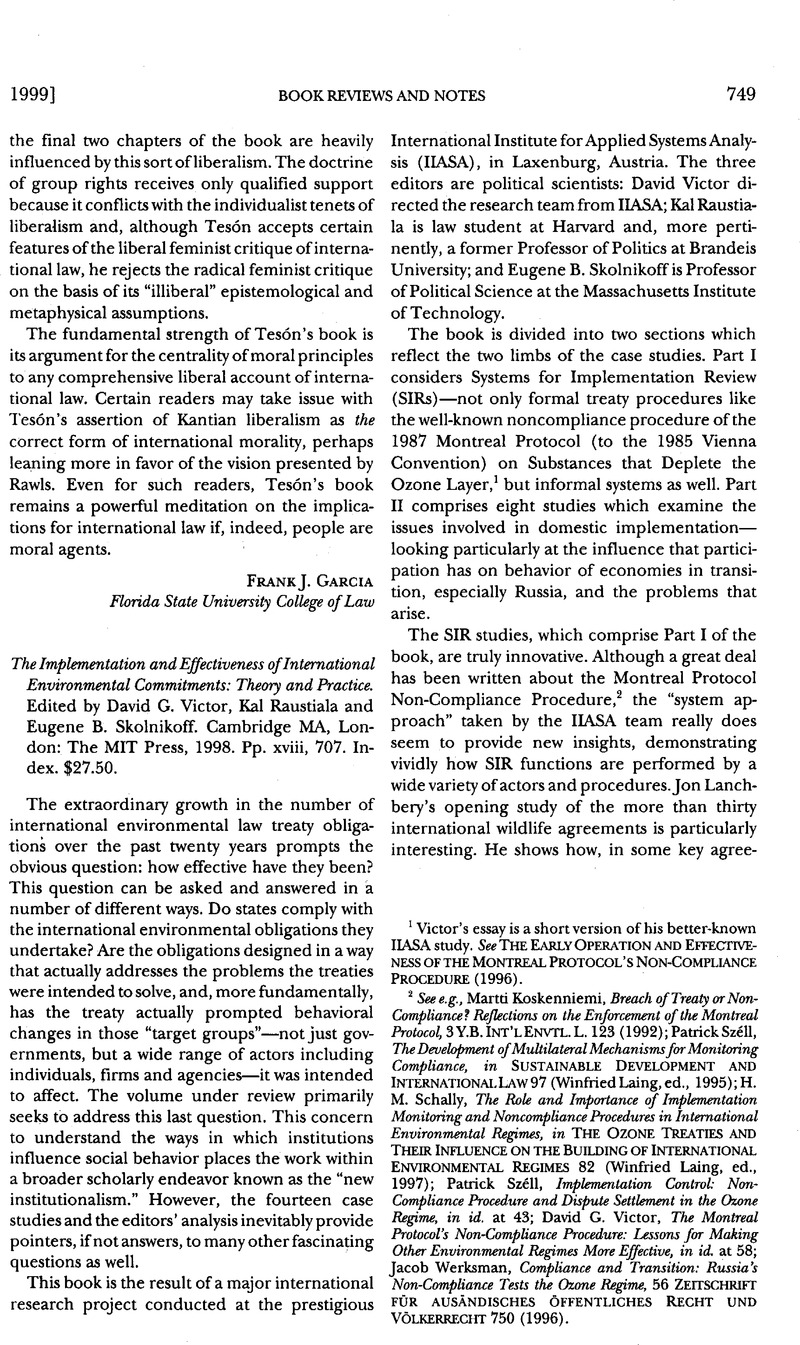Article contents
The Implementation and Effectiveness of International Environmental Commitments: Theory and Practice. Edited by David G. Victor, Kal Raustiala and Eugene B. Skolnikoff. Cambridge MA, London: The MIT Press, 1998. Pp. xviii, 707. Index. $27.50.
Published online by Cambridge University Press: 27 February 2017
Abstract

- Type
- Book Reviews and Notes
- Information
- Copyright
- Copyright © American Society of International Law 1999
References
1 Victor’s essay is a short version of his better-known IIASA Study. See The Early Operation and Effectiveness of the Montreal Protocol’s Non-Compliance Procedure (1996).
2 See e.g., Martti Koskenniemi, Breach of Treaty or Non-Compliance? Reflections on the Enforcement of the Montreal Protocol, 3 Y.B. Int’l Envtl. L. 123 (1992); Patrick Széll, The Development of Multilateral Mechanisms for Monitoring Compliance, in Sustainable Development and International Law 97 (Winfried Laing, ed., 1995); H. M. Schally, The Role and Importance of Implementation Monitoring and Noncompliance Procedures in International Environmental Regimes, in The Ozone Treaties and Their Influence on the Building of International Environmental Regimes 82 (Winfried Laing, ed., 1997); Patrick Széll, Implementation Control: Non-Compliance Procedure and Dispute Settlement in the Ozone Regime, in id. at 43; David G. Victor, The Montreal Protocol’s Non-Compliance Procedure: Lessons for Making Other Environmental Regimes More Effective, in id. at 58; Jacob Werksman, Compliance and Transition: Russia’s Non-Compliance Tests the Ozone Regime, 56 Zeitschrift Für Ausändisches Öffentliches Recht und Völkerrecht 750 (1996).
3 See Convention on Wetlands of International Importance especially as Waterfowl Habitat, Feb. 2, 1971, 996 UNTS 245, 11 ILM 969 (1972).
4 See Convention on International Trade in Endangered Species of Wild Fauna and Flora, March 3, 1973, 993 UNTS 243, 12 ILM 1085 (1973).
5 See Convention on the Protection of the Marine Environment of the Baltic Sea Area, Apr. 9, 1992, 1993 O.J. (C 226) 9.
6 See Convention on the Prevention of Marine Pollution by Dumping of Wasstes and Other Matter (London Convention), Nov. 13, 1046 UNTS 120, 11 ILM 1294 (1972).
7 The International Whaling Commission meets annually. One of its important duties is the annual update of the Schedule to the 1946 Convention “based on scientific findings” (Article V(2)(b)). In 1982 at its 34th Meeting, the IWC adopted a de facto moratorium on whaling by agreeing that “catch limits for all the killing for commercial purposes of whale from all stocks for the 1986 coastal season and the 1985/1986 pelagic seasons and thereafter shall be zero.” (Para. 10(e) of the Schedule to the Convention). See further, The International Regulation of Whaling (Patricia Birnie ed., 1985). The convention has an “objection procedure” (Article V(3)) whereby amendments are not binding on states which object within 90 days.
8 See United Nations Conference on Environment and Development: Framework Convention on Climate Change, May 9, 1992, S. Treaty Doc. No. 102-38, 31 ILM 849 (1992).
9 Kyoto Protocol to the FCCC, FCCC Conference of he Parties, 3d Sess., UN Doc. FCC/CP/1997/L.7/Add.1 (Dec. 10, 1997) (text did not represent the final version), 31 ILM 22 (1998). The final version of the Kyoto Protocol was issued as part of the Third Conference of the Parties Report, UN Doc. FCCC/CP/1997/7/Add.2.
10 Decision on the “Buenos Aires Plan of Action” adopted by the Parties to the UNFCCC, Nov. 14, 1998, Decision 1/CP.4. See also UN Doc. FCCC/CP1998/L.23.
- 3
- Cited by


